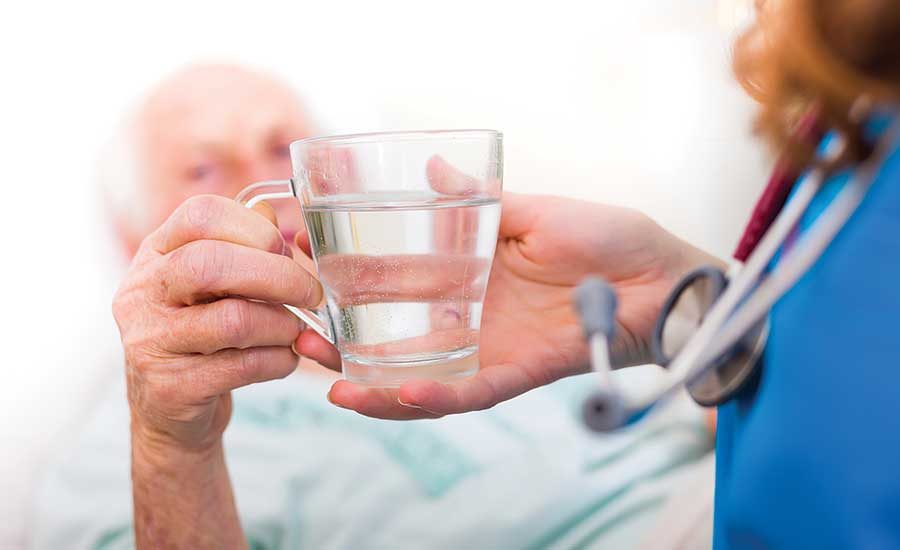Best Practices for Legionella Mitigation – Part One
Water Safety in Health Care Facilities
Why not all water management programs are created equal

The spread of Legionella and other waterborne pathogens can occur through ingestion, inhalation and dermal contact.
According to the American Hospital Association, nearly 37 million people are admitted to a hospital every year in the United States. Hospitals and health care facilities have a more varied population than other buildings due to the range of ages and the conditions for which patients are treated.
These facilities have complex water systems that require consistent management and oversight by facility staff. Managing the operation of these water systems can especially be a challenge for facilities that do not have the support of their network to implement needed repairs or replace equipment. Consequently, inadequately maintained health care facilities have been the source of waterborne diseases such as Legionnaires’ disease: an acute respiratory disease caused by Legionella bacteria.

Senior citizens and the immunocompromised are especially vulnerable to waterborne diseases in health care facilities.
Based on findings from the Centers for Disease Control and Prevention, nine out of 10 cases of Legionnaires’ disease could be prevented with better water management. The Centers for Medicare & Medicaid Services goes even further. CMS now requires all hospitals, long-term care centers and skilled nursing homes to perform an environmental assessment, develop a water management program, and establish a sampling and monitoring strategy for their facilities. There are, however, no such consistent requirements for a health care facility’s water management program. Initial programs may only include a copy of the CDC toolkit for preventing Legionnaires’ disease, which is essentially filled in with basic information about the facility. Furthermore, the programs typically focus only on utility systems.
Current guidance, including the CMS requirements, requires health care facilities to focus on more water systems than just drinking water systems — and on pathogens other than Legionella. A 2019 study of non-Legionella infection risks published by the CDC showed that investigations of non-tuberculous mycobacteria (NTM) accounted for the greatest number of investigations (29.9%), followed by Pseudomonas spp. (18.7%) and Burkholderia spp. (10.4%). Several possible exposure pathways and routes of transmission were identified, including contaminated sink drains, contaminated dialysis wall boxes, use of contaminated water in dental water lines, use of nonsterile water and inadequate disinfection of heater-cooler units used during cardiac surgery, water from contaminated showerheads and building water leaks in patient care areas. This demonstrates the need for facilities to establish procedures for maintaining their utility water systems, and including medical devices in their overall water management program. This requires a multidisciplinary team consisting of senior leadership, facility engineering, biomedical engineering, nursing and vendors.
The health care facility management team must work together to perform an environmental assessment of the entire facility, identifying areas of high risk due to patient populations and the presence of hazardous conditions. It is important to walk the facility and not rely on engineering drawings. The risk assessment and existing procedures, such as device manufacturer’s operating requirements, should be used to develop the water management program. The team must communicate regularly on the implementation of the program to ensure all actions are performed according to the established procedures. Documentation of these actions is essential to verify the program is being implemented as designed, and for the team to be able to review the effectiveness of the program on an ongoing basis.
This topic of achieving public health goals in a health care setting is so pervasive, it was discussed in length during the recent Legionella Conference co-presented by NSF International and the National Environmental Health Association (NEHA). Industry experts involved in this year’s annual conference, titled “Building Water Systems: The Sustainability and Public Health Nexus,” came to similar conclusions described in this article.
While it may seem daunting to develop a comprehensive plan that does more than just meet minimum regulatory expectations, the benefits of establishing a water safety culture in health care environments are worth the prevention efforts. In most cases, many of the cleaning, disinfection and monitoring activities required in a water management program are already being performed. It is also important for senior leadership to take an active role in encouraging proactive water management and consistent collaboration.
|
Andrew Ward, is the senior technical reviewer for the building water health division of the water systems program at NSF International. |









